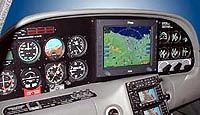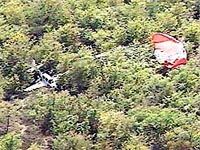Aircraft Safety Versus Pilot Complacency…
 As Cirrus Design rolled out its first two full glass cockpit-outfitted SR22s last week, Cirrus CEO Alan Klapmeier told AVweb the company is bringing together a group of experts from industry, government and universities to explore how improved technology and aircraft safety may affect the pilots who fly the airplanes. What Cirrus hopes to determine is whether easier-to-fly, more comfortable and technologically advanced airplanes lower the guard of those flying them. The group will study a string of Cirrus accidents, which (except the famous dangling-aileron incident in Texas last fall) seemingly had nothing to do with the airplane itself. “It’s not good enough to say that it’s pilot error and it’s not our problem,” said Klapmeier. “One of those questions becomes [one of] complacency,” he said. “As the airplane’s easier to fly … are we losing focus along the way?” He said there have already been studies done on the effects of safety improvements in cars on driver attitude and action and some of that data might apply to this research. Klapmeier said he’s hoping to have a report in about two months. As appealing as the clean, modern appearance of the aircraft and its new electronic panelmay be, the whole idea, Klapmeier told AVweb,is to make the airplanes easier and safer to fly — something that has been the company philosophy from the start.
As Cirrus Design rolled out its first two full glass cockpit-outfitted SR22s last week, Cirrus CEO Alan Klapmeier told AVweb the company is bringing together a group of experts from industry, government and universities to explore how improved technology and aircraft safety may affect the pilots who fly the airplanes. What Cirrus hopes to determine is whether easier-to-fly, more comfortable and technologically advanced airplanes lower the guard of those flying them. The group will study a string of Cirrus accidents, which (except the famous dangling-aileron incident in Texas last fall) seemingly had nothing to do with the airplane itself. “It’s not good enough to say that it’s pilot error and it’s not our problem,” said Klapmeier. “One of those questions becomes [one of] complacency,” he said. “As the airplane’s easier to fly … are we losing focus along the way?” He said there have already been studies done on the effects of safety improvements in cars on driver attitude and action and some of that data might apply to this research. Klapmeier said he’s hoping to have a report in about two months. As appealing as the clean, modern appearance of the aircraft and its new electronic panelmay be, the whole idea, Klapmeier told AVweb,is to make the airplanes easier and safer to fly — something that has been the company philosophy from the start.
…Accidents Versus Customer Profile…
 Klapmeier said Cirrus thoroughly examined the backgrounds, ages, and flight experience of its more than 700 customers and was unable to find any common threads. “The data is all over the place,” he said. Klapmeier rejects the often-suggested theory that the existence of the parachute causes pilots to take more chances. “It’s much more subtle than that,” he said. Of the six fatal crashes, Klapmeier said five resulted from controlled flight into terrain, four of which were in IMC. However, only in one instance does the NTSB’s preliminary report indicate the pilot held more than a private certificate. In one fatal crash, a spin/stall accident, the solution may have been at the pilot’s fingertips. “He should have pulled the chute. In fact, the FAA says you must pull the chute,” said Klapmeier. If the study does determine that luxury (modern cockpit), convenience (higher-performance) and safety (whole-plane parachute) leads to complacency, Klapmeier said the answer will not be to remove those features but to train pilots to use them effectively, without forgetting where they are. “Even though the airplane is easy to fly, you can’t take it for granted,” he said. “We build a very safe airplane. We want to make the whole operation safer.”
Klapmeier said Cirrus thoroughly examined the backgrounds, ages, and flight experience of its more than 700 customers and was unable to find any common threads. “The data is all over the place,” he said. Klapmeier rejects the often-suggested theory that the existence of the parachute causes pilots to take more chances. “It’s much more subtle than that,” he said. Of the six fatal crashes, Klapmeier said five resulted from controlled flight into terrain, four of which were in IMC. However, only in one instance does the NTSB’s preliminary report indicate the pilot held more than a private certificate. In one fatal crash, a spin/stall accident, the solution may have been at the pilot’s fingertips. “He should have pulled the chute. In fact, the FAA says you must pull the chute,” said Klapmeier. If the study does determine that luxury (modern cockpit), convenience (higher-performance) and safety (whole-plane parachute) leads to complacency, Klapmeier said the answer will not be to remove those features but to train pilots to use them effectively, without forgetting where they are. “Even though the airplane is easy to fly, you can’t take it for granted,” he said. “We build a very safe airplane. We want to make the whole operation safer.”
…And How It’s Supposed To Work
 Against the backdrop of tragedy, there is one shining example of technology and pilot working together for the best possible outcome. Last October, as Lionel Morrison was flying his Cirrus home from a maintenance stop at Addison Airport in Texas, the left aileron partially detached. Morrison’s response was by the book. He could still control the plane marginally so he got it to a safe altitude over an unpopulated area and pulled the parachute. The aircraft settled, nose down, in a bushy area beside a highway and Morrison walked away virtually uninjured. Since then, Morrison has acquired another Cirrus and Cirrus has acquired a unique promotional aid. “We ended up buying [Morrison’s plane] back,” said Klapmeier. “We’re going to repair it and fly it again.” Cirrus tells its customers that they should consider the airplane a total loss if the chute is deployed. But in the case of Morrison’s plane, the damage was so minimal that it can be easily made flight-worthy. Klapmeier said the engine has to be inspected and there is some damage to the airframe from the trees but they should have it flying shortly after it’s released by various investigating authorities.
Against the backdrop of tragedy, there is one shining example of technology and pilot working together for the best possible outcome. Last October, as Lionel Morrison was flying his Cirrus home from a maintenance stop at Addison Airport in Texas, the left aileron partially detached. Morrison’s response was by the book. He could still control the plane marginally so he got it to a safe altitude over an unpopulated area and pulled the parachute. The aircraft settled, nose down, in a bushy area beside a highway and Morrison walked away virtually uninjured. Since then, Morrison has acquired another Cirrus and Cirrus has acquired a unique promotional aid. “We ended up buying [Morrison’s plane] back,” said Klapmeier. “We’re going to repair it and fly it again.” Cirrus tells its customers that they should consider the airplane a total loss if the chute is deployed. But in the case of Morrison’s plane, the damage was so minimal that it can be easily made flight-worthy. Klapmeier said the engine has to be inspected and there is some damage to the airframe from the trees but they should have it flying shortly after it’s released by various investigating authorities.
As Cirrus Design rolled out its first two full glass cockpit-outfitted SR22s last week, Cirrus CEO Alan Klapmeier told AVweb the company is bringing together a group of experts from industry, government and universities to explore how improved technology and aircraft safety may affect the pilots who fly the airplanes. What Cirrus hopes to determine is whether easier-to-fly, more comfortable and technologically advanced airplanes lower the guard of those flying them. The group will study a string of Cirrus accidents, which (except the famous dangling-aileron incident in Texas last fall) seemingly had nothing to do with the airplane itself. “It’s not good enough to say that it’s pilot error and it’s not our problem,” said Klapmeier. “One of those questions becomes [one of] complacency,” he said. “As the airplane’s easier to fly … are we losing focus along the way?” He said there have already been studies done on the effects of safety improvements in cars on driver attitude and action and some of that data might apply to this research. Klapmeier said he’s hoping to have a report in about two months. As appealing as the clean, modern appearance of the aircraft and its new electronic panelmay be, the whole idea, Klapmeier told AVweb,is to make the airplanes easier and safer to fly — something that has been the company philosophy from the start.
Klapmeier said Cirrus thoroughly examined the backgrounds, ages, and flight experience of its more than 700 customers and was unable to find any common threads. “The data is all over the place,” he said. Klapmeier rejects the often-suggested theory that the existence of the parachute causes pilots to take more chances. “It’s much more subtle than that,” he said. Of the six fatal crashes, Klapmeier said five resulted from controlled flight into terrain, four of which were in IMC. However, only in one instance does the NTSB’s preliminary report indicate the pilot held more than a private certificate. In one fatal crash, a spin/stall accident, the solution may have been at the pilot’s fingertips. “He should have pulled the chute. In fact, the FAA says you must pull the chute,” said Klapmeier. If the study does determine that luxury (modern cockpit), convenience (higher-performance) and safety (whole-plane parachute) leads to complacency, Klapmeier said the answer will not be to remove those features but to train pilots to use them effectively, without forgetting where they are. “Even though the airplane is easy to fly, you can’t take it for granted,” he said. “We build a very safe airplane. We want to make the whole operation safer.”
Against the backdrop of tragedy, there is one shining example of technology and pilot working together for the best possible outcome. Last October, as Lionel Morrison was flying his Cirrus home from a maintenance stop at Addison Airport in Texas, the left aileron partially detached. Morrison’s response was by the book. He could still control the plane marginally so he got it to a safe altitude over an unpopulated area and pulled the parachute. The aircraft settled, nose down, in a bushy area beside a highway and Morrison walked away virtually uninjured. Since then, Morrison has acquired another Cirrus and Cirrus has acquired a unique promotional aid. “We ended up buying [Morrison’s plane] back,” said Klapmeier. “We’re going to repair it and fly it again.” Cirrus tells its customers that they should consider the airplane a total loss if the chute is deployed. But in the case of Morrison’s plane, the damage was so minimal that it can be easily made flight-worthy. Klapmeier said the engine has to be inspected and there is some damage to the airframe from the trees but they should have it flying shortly after it’s released by various investigating authorities.


































